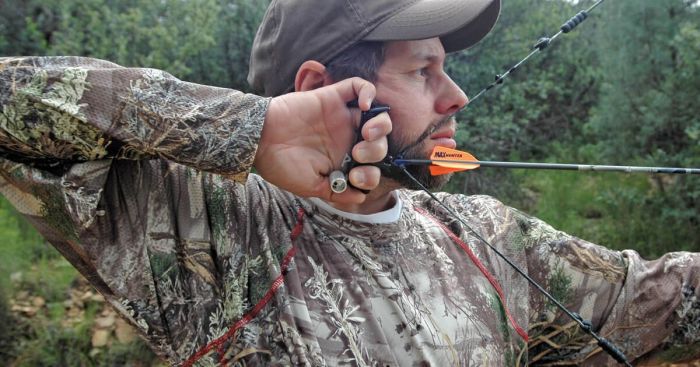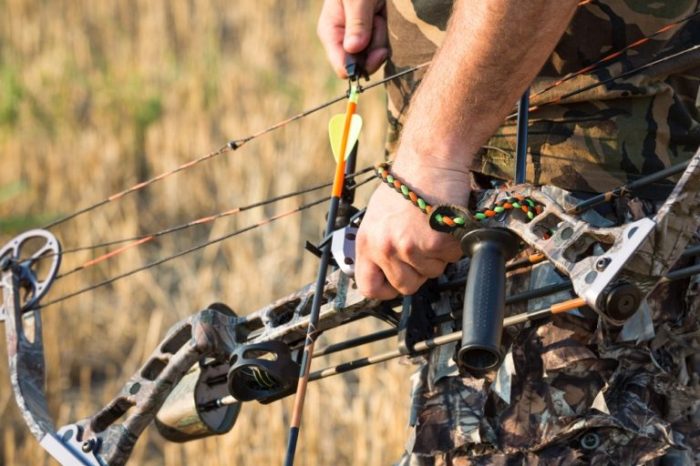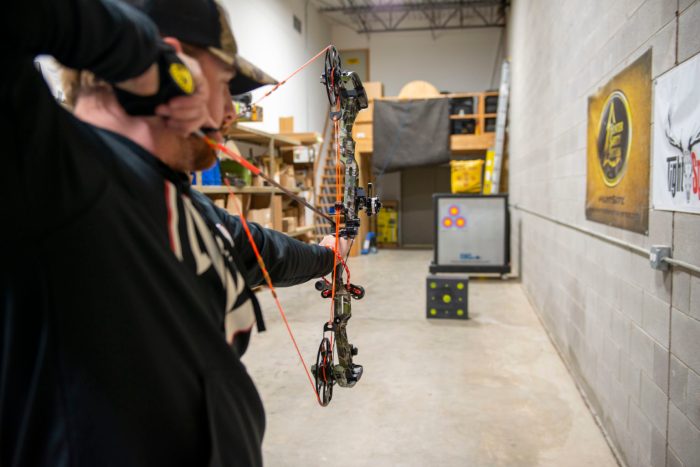The main advantage of being a bowhunter lies in the unparalleled physical, mental, and social benefits it offers. Embark on a journey to discover the transformative power of bowhunting, from its cardiovascular enhancements to its profound impact on well-being and community building.
As you delve into the intricacies of bowhunting, you will witness its remarkable ability to cultivate patience, focus, and self-discipline. The pursuit of game in its natural habitat fosters a deep connection with nature, fostering respect for wildlife and the environment.
Physical Benefits
Engaging in bowhunting offers a myriad of physical advantages that contribute to overall well-being. These benefits range from improved cardiovascular health to enhanced muscular strength, endurance, flexibility, and coordination.
Cardiovascular Health
Bowhunting is an aerobic activity that requires sustained physical exertion over extended periods. This type of exercise strengthens the heart and improves its pumping efficiency. Regular bowhunting sessions can lead to increased blood flow, reduced blood pressure, and a lower risk of cardiovascular diseases.
Muscular Strength and Endurance
Drawing a bow requires significant upper body strength, particularly in the arms, shoulders, and back. Repeatedly drawing and holding the bow builds muscle mass and improves muscular endurance. Bowhunters also engage in activities such as hiking, climbing, and carrying gear, which further contribute to overall strength and endurance.
Flexibility and Coordination
The movements involved in bowhunting, such as drawing the bow and aiming, require a high degree of flexibility and coordination. Maintaining proper form and balance while shooting the bow enhances these physical attributes. Bowhunting also improves hand-eye coordination, which is essential for accurate shooting.
Mental and Emotional Advantages
Bowhunting offers numerous mental and emotional benefits that contribute to overall well-being. The immersive experience of bowhunting promotes stress relief, fostering patience, focus, and self-discipline. Additionally, the successful culmination of a hunt often evokes a profound sense of accomplishment and fulfillment.
Stress Relief
The serene and contemplative nature of bowhunting provides a respite from the stressors of daily life. Immersed in the tranquility of the natural environment, hunters can escape the pressures and anxieties that often accompany modern society. The act of focusing on the hunt and observing the surroundings has a calming effect, reducing stress levels and promoting relaxation.
Patience, Focus, and Self-Discipline
Bowhunting demands patience, focus, and self-discipline. The waiting game involved in hunting, often requiring hours of stillness and observation, cultivates patience and the ability to remain composed under pressure. Additionally, the precision required in bowhunting, from arrow placement to shot execution, fosters focus and concentration.
Sense of Accomplishment and Fulfillment
A successful bowhunting experience brings a deep sense of accomplishment and fulfillment. The culmination of months of preparation, practice, and the physical and mental challenges encountered during the hunt make the successful harvest of an animal a significant achievement. This sense of accomplishment not only boosts self-esteem but also reinforces the connection to nature and the appreciation of the food we consume.
Social Benefits
Bowhunting offers a unique opportunity for camaraderie and community building. Hunters share a common passion for the outdoors and a deep respect for nature. They often form strong bonds through shared experiences, such as hunting trips, archery tournaments, and conservation projects.
Responsible Hunting Practices and Conservation Efforts
Bowhunting promotes responsible hunting practices. Bowhunters are required to pass rigorous training and certification programs before they can hunt. This ensures that they are proficient in archery skills and knowledgeable about hunting ethics and regulations. Bowhunters also play a vital role in conservation efforts.
They contribute to wildlife management programs and support organizations that protect and preserve wildlife habitats.
Respect for Nature and Wildlife
Bowhunting fosters a deep respect for nature and wildlife. Hunters spend countless hours observing and studying animals in their natural habitats. This close connection with nature helps them develop a profound appreciation for the beauty and complexity of the natural world.
Bowhunters also recognize the importance of ethical hunting practices and strive to minimize their impact on the environment.
Skills Development
Bowhunting necessitates the acquisition of a diverse array of technical skills, including proficiency in archery and the ability to track game effectively. The pursuit of bowhunting demands a deep understanding of archery techniques, encompassing proper form, shot placement, and range estimation.
Moreover, bowhunters must develop the ability to track their quarry through various terrains and weather conditions, relying on keen observation and an intimate knowledge of animal behavior.
Problem-Solving and Decision-Making
Bowhunting presents numerous challenges that necessitate the development of problem-solving and decision-making capabilities. Bowhunters must constantly assess their surroundings, evaluate potential risks, and make informed decisions to ensure a successful hunt. The ability to adapt to changing conditions, anticipate animal movements, and formulate strategies for approaching and harvesting game are essential skills that are honed through the practice of bowhunting.
Self-Reliance and Independence
Bowhunting fosters a sense of self-reliance and independence, as it requires individuals to be resourceful and adaptable in the wilderness. Bowhunters must be able to navigate unfamiliar terrain, set up camp, and care for themselves without relying on external support.
This experience instills a deep sense of self-sufficiency and confidence in one’s ability to overcome challenges and achieve goals.
Cultural and Historical Significance
Bowhunting has deep historical roots, with evidence of its practice dating back thousands of years. It played a crucial role in the survival and sustenance of ancient human societies, serving as a primary means of acquiring food and other resources.
The cultural significance of bowhunting extends beyond its practical utility, as it has been intricately woven into the traditions, beliefs, and art of numerous cultures worldwide.
Historical Roots
Archaeological findings indicate that bowhunting emerged during the Upper Paleolithic era, approximately 40,000 to 10,000 years ago. Cave paintings and artifacts from this period depict humans using bows and arrows to hunt animals for food and clothing. Bowhunting remained a primary hunting method throughout the Neolithic and Bronze Ages, as evidenced by the discovery of bows, arrows, and arrowheads in archaeological sites.
Ethical Considerations

Bowhunting carries ethical responsibilities that extend beyond the pursuit of game. Bowhunters must adhere to responsible hunting practices and demonstrate respect for wildlife. Ethical decision-making is crucial to ensure the sustainability of wildlife populations and preserve the integrity of the sport.
Responsible Hunting Practices, Main advantage of being a bowhunter
Responsible hunting practices include following all applicable laws and regulations, practicing fair chase, and using appropriate equipment. Bowhunters must avoid taking unethical shots, such as shooting at animals that are too far away or at a disadvantage. They should also refrain from hunting over bait or using artificial scents or sounds to attract game.
Respect for Wildlife
Respect for wildlife means understanding the animal’s behavior and habitat, and treating it with dignity. Bowhunters should avoid causing unnecessary suffering or harm to animals. They should also respect the animal’s natural environment and leave it undisturbed.
Contribution to Wildlife Conservation and Management
Bowhunters can contribute to wildlife conservation and management by participating in research and monitoring programs, and by advocating for policies that support sustainable hunting practices. They can also support organizations that work to protect wildlife habitat and promote ethical hunting.
Gear and Equipment

Bowhunting requires specialized gear and equipment to ensure accuracy, safety, and effectiveness. Understanding the different types of bows, arrows, and accessories is crucial for success in this demanding sport.
Types of Bows
There are several types of bows used in bowhunting, each with unique characteristics and advantages. The most common types include:
- Recurve Bows:Traditional bows with curved limbs that provide increased power and accuracy.
- Compound Bows:Modern bows with a system of pulleys and cables that reduce draw weight and increase arrow speed.
- Longbows:Traditional bows with straight limbs that require more strength to draw but offer a classic hunting experience.
Types of Arrows
Arrows are equally important in bowhunting, affecting accuracy, penetration, and trajectory. Different types of arrows include:
- Carbon Arrows:Lightweight and durable arrows made from carbon fiber, providing high speeds and accuracy.
- Aluminum Arrows:More affordable than carbon arrows but heavier, resulting in slower speeds and less penetration.
- Wood Arrows:Traditional arrows made from natural wood, offering a classic aesthetic but lower durability.
Bowhunting Accessories
Numerous accessories enhance the bowhunting experience, including:
- Sights:Optical devices that aid in aiming and improving accuracy.
- Releases:Mechanical devices that connect the bowstring to the archer’s hand, allowing for a clean and consistent release.
- Quivers:Containers that hold arrows and keep them secure during hunting.
Hunting Techniques: Main Advantage Of Being A Bowhunter

Bowhunting requires a wide range of techniques to effectively pursue game in various hunting scenarios. Understanding and mastering these techniques enhances the hunter’s success rate and overall hunting experience.
There are several fundamental bowhunting techniques that have proven effective over time. Each technique has its strengths and is suitable for different hunting environments and game species. The most common bowhunting techniques include spot-and-stalk, treestand, and ground blind.
Spot-and-Stalk
Spot-and-stalk is a dynamic hunting technique where the hunter actively searches for game by moving through the hunting area and taking advantage of natural cover and terrain. This technique requires excellent stalking skills, patience, and the ability to make quick and accurate shots.
Spot-and-stalk is particularly effective in areas with open terrain or where game is not easily spooked.
Treestand
Treestand hunting involves setting up an elevated platform in a tree to gain a vantage point and increase the chances of spotting game. Treestands provide a concealed and stable shooting position, making them suitable for hunting in areas with dense vegetation or where game is wary of ground-level movement.
Treestand hunting requires proper safety precautions and a good understanding of tree stand placement and safety protocols.
Ground Blind
Ground blinds are portable structures that provide concealment for the hunter while allowing them to observe and shoot game from a seated or kneeling position. Ground blinds are versatile and can be used in various hunting environments, from open fields to dense forests.
They are particularly effective for hunting game that is easily spooked or wary of human presence.The choice of bowhunting technique depends on several factors, including the terrain, game species, weather conditions, and the hunter’s personal preferences and skills. By mastering different bowhunting techniques, hunters can adapt to various hunting scenarios and increase their chances of success.
Hunting Locations

Bowhunting locations vary widely, offering diverse opportunities for hunters. Selecting the ideal location depends on the desired game species, terrain, climate, and regulations.
Prime Bowhunting Locations
| Location | Unique Features | Game Species |
|---|---|---|
| North America | Vast wilderness areas, abundant game, and well-established infrastructure. | Whitetail deer, mule deer, elk, moose, black bear, and pronghorn antelope. |
| Africa | Exotic game species, stunning landscapes, and cultural immersion. | Cape buffalo, elephant, lion, leopard, and various antelope species. |
| Asia | Diverse terrain, ancient hunting traditions, and unique game species. | Asian water buffalo, gaur, nilgai, tahr, and serow. |
| Europe | Historic hunting grounds, dense forests, and challenging game. | Red deer, roe deer, wild boar, and chamois. |
| South America | Tropical rainforests, vast savannas, and a wide range of game. | Capybara, peccary, jaguar, tapir, and giant anteater. |
Factors to Consider
* Game Species:Determine the desired game species and research locations where they are abundant.
Terrain and Climate
Consider the physical demands of the terrain and the suitability of the climate for hunting.
Regulations and Hunting Seasons
Familiarize yourself with the hunting regulations, including seasons, bag limits, and license requirements.
Access and Infrastructure
Ensure accessibility to the hunting area and consider the availability of amenities such as lodging, transportation, and guides.
Regulations and Hunting Seasons
Hunting regulations and seasons vary by location and game species. It is crucial to research and abide by these regulations to ensure ethical and legal hunting practices.
Wildlife Conservation
Bowhunters play a crucial role in wildlife conservation efforts. Their selective harvesting practices contribute to the management of wildlife populations, ensuring their sustainability and preventing overpopulation.
Bowhunting also contributes to habitat preservation. The funds generated from hunting licenses and tags often support conservation programs that protect and enhance wildlife habitats. Additionally, bowhunters actively participate in habitat improvement projects, such as planting food plots and clearing invasive species.
Bowhunting Organizations and Initiatives
Numerous bowhunting organizations and initiatives are dedicated to wildlife conservation. These organizations promote ethical hunting practices, conduct research, and advocate for policies that support wildlife management and habitat protection.
- Bowhunters United
- National Bowhunter Education Foundation
- Pope and Young Club
- Safari Club International
- Wild Sheep Foundation
FAQ Corner
What are the physical benefits of bowhunting?
Bowhunting offers numerous physical benefits, including improved cardiovascular health, enhanced muscular strength and endurance, and increased flexibility and coordination.
How does bowhunting contribute to mental well-being?
Bowhunting promotes stress relief, fosters patience, focus, and self-discipline, and provides a sense of accomplishment and fulfillment.
What are the social benefits of bowhunting?
Bowhunting fosters camaraderie and community building, promotes responsible hunting practices and conservation efforts, and cultivates respect for nature and wildlife.